Developing a Positive Safety Culture in a Workplace: Final Project
VerifiedAdded on 2020/05/16
|62
|11728
|68
Project
AI Summary
This final year project from Leeds Metropolitan University explores the development of a positive safety culture within an interior design workplace. The research investigates the significance of workplace safety, its impact on employee well-being and organizational performance, and the challenges faced in the interior design industry. The project includes a literature review covering commitment to safety, employee involvement, hazard identification, training, and continuous improvement. The methodology involves surveys and interviews to collect data, analyzed using Excel. Findings reveal that management does not prioritize safety, and employees lack awareness, leading to recommendations for building a safety culture through written processes and employee education. The project identifies instruments/equipment hazards, behavioral/psychological aspects, challenges, and interventions to enhance workplace safety.
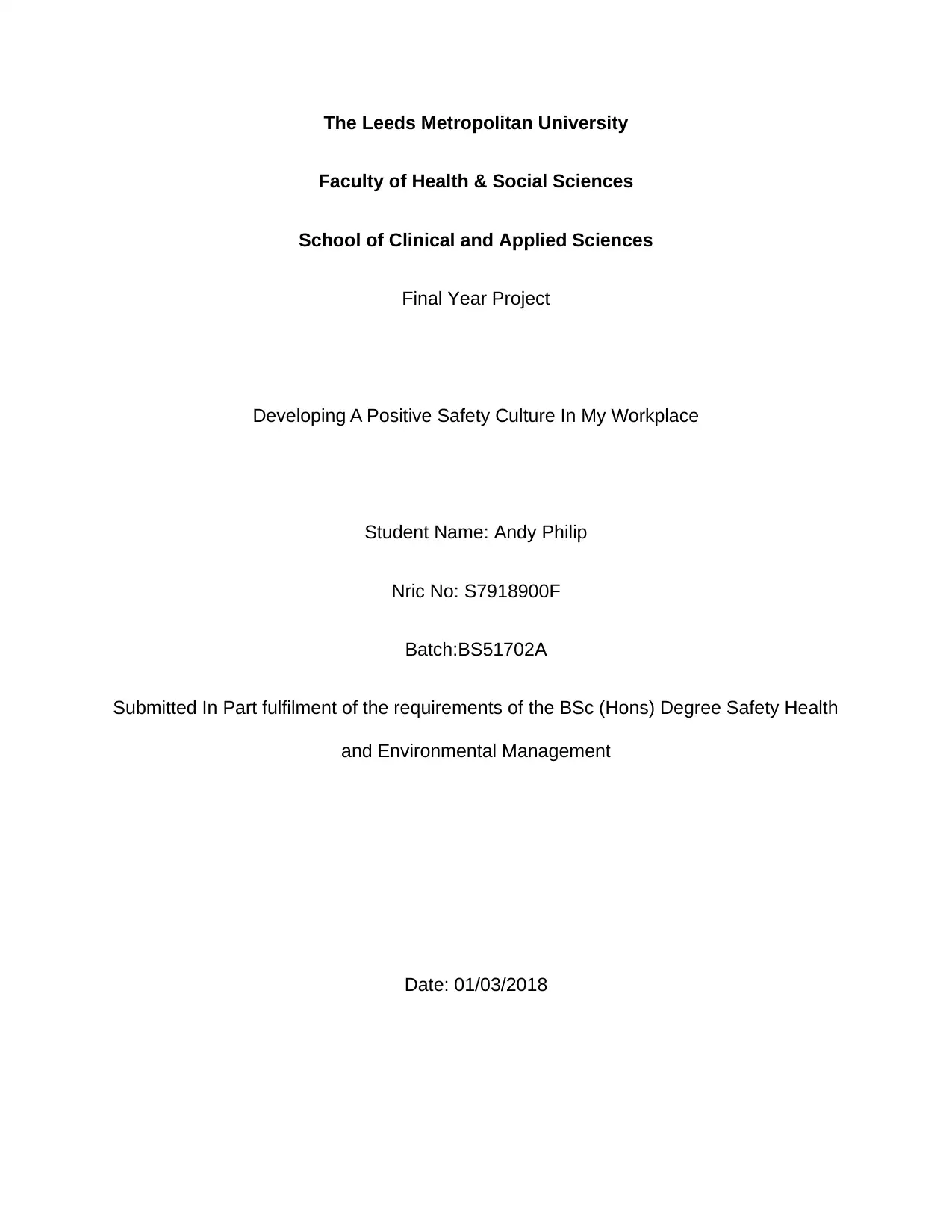
The Leeds Metropolitan University
Faculty of Health & Social Sciences
School of Clinical and Applied Sciences
Final Year Project
Developing A Positive Safety Culture In My Workplace
Student Name: Andy Philip
Nric No: S7918900F
Batch:BS51702A
Submitted In Part fulfilment of the requirements of the BSc (Hons) Degree Safety Health
and Environmental Management
Date: 01/03/2018
Faculty of Health & Social Sciences
School of Clinical and Applied Sciences
Final Year Project
Developing A Positive Safety Culture In My Workplace
Student Name: Andy Philip
Nric No: S7918900F
Batch:BS51702A
Submitted In Part fulfilment of the requirements of the BSc (Hons) Degree Safety Health
and Environmental Management
Date: 01/03/2018
Paraphrase This Document
Need a fresh take? Get an instant paraphrase of this document with our AI Paraphraser

1
DEVELOPING A POSITIVE SAFETY CULTURE IN MY WORKPLACE
Abstract
Workplace safety is an important factor that affects the culture of the work environment
and directly influences the well being of the workers and performance of the
organisation. Accident prone workplaces have significantly lower productivity and
employee satisfaction, as well as having a negative effect on the company. The study
aims to understand the different challenges and concerns related to safety culture in
interior designing industry, utilizing observations, surveys and interviews. In this
research project, I have chosen my workplace to analyse the need for positive safety
workplace culture. There are five chapters in this research project. In the first chapter,
background, rationale of the research, aim, objectives and questions have been
discussed. In the second chapter, secondary literature has been explained. The OSHA
mandates both employers and employees to partake in activities to ensure a safe and
healthy work environment, and its guidelines have been legislated by Workers Safety
and Health protocols. The objective is to identify the different scopes for improvement in
the existing work culture and promote wellness and safety. Such activity will be
conducted with permission from the ethical board and management and will help to
analyse compliance with the safety guidelines mandated by legal statutes and
organisational policies.
In order to collect the data, I have conducted survey and interview in my workplace.
Survey responses have been taken from the staffs and interviews have been conducted
with the managers. Proper ethics have been followed in order to conduct the data. Excel
bar graph and pie-chart have been used to present the quantitative data in chapter four.
This research found out that management does not provide importance in interior
DEVELOPING A POSITIVE SAFETY CULTURE IN MY WORKPLACE
Abstract
Workplace safety is an important factor that affects the culture of the work environment
and directly influences the well being of the workers and performance of the
organisation. Accident prone workplaces have significantly lower productivity and
employee satisfaction, as well as having a negative effect on the company. The study
aims to understand the different challenges and concerns related to safety culture in
interior designing industry, utilizing observations, surveys and interviews. In this
research project, I have chosen my workplace to analyse the need for positive safety
workplace culture. There are five chapters in this research project. In the first chapter,
background, rationale of the research, aim, objectives and questions have been
discussed. In the second chapter, secondary literature has been explained. The OSHA
mandates both employers and employees to partake in activities to ensure a safe and
healthy work environment, and its guidelines have been legislated by Workers Safety
and Health protocols. The objective is to identify the different scopes for improvement in
the existing work culture and promote wellness and safety. Such activity will be
conducted with permission from the ethical board and management and will help to
analyse compliance with the safety guidelines mandated by legal statutes and
organisational policies.
In order to collect the data, I have conducted survey and interview in my workplace.
Survey responses have been taken from the staffs and interviews have been conducted
with the managers. Proper ethics have been followed in order to conduct the data. Excel
bar graph and pie-chart have been used to present the quantitative data in chapter four.
This research found out that management does not provide importance in interior

2
DEVELOPING A POSITIVE SAFETY CULTURE IN MY WORKPLACE
design organisation workplace. The employees are not fully aware of the fact and
management is reluctant about workplace safety and health. It has been recommended
that workplace safety culture needs to be built through written comments and educating
the employees in proper ways.
DEVELOPING A POSITIVE SAFETY CULTURE IN MY WORKPLACE
design organisation workplace. The employees are not fully aware of the fact and
management is reluctant about workplace safety and health. It has been recommended
that workplace safety culture needs to be built through written comments and educating
the employees in proper ways.
⊘ This is a preview!⊘
Do you want full access?
Subscribe today to unlock all pages.

Trusted by 1+ million students worldwide

3
DEVELOPING A POSITIVE SAFETY CULTURE IN MY WORKPLACE
Table of Contents
Chapter 1: Introduction.....................................................................................................8
1.1 Background of the project.......................................................................................8
1.2 Rationale of the project...........................................................................................9
1.3 Aim....................................................................................................................... 10
1.4 Objectives.............................................................................................................11
1.4 Research questions..............................................................................................11
Chapter 2: Literature review...........................................................................................12
2.1 Making a commitment to safety culture................................................................12
2.2 Involving Employees for safety concerns.............................................................13
2.3 Identifying and controlling hazards.......................................................................14
2.4 Training needs of the staffs..................................................................................15
2.5 Supporting a Safe culture with behavioural and psychological aspects of safety. 16
2.6 Continued Improvement of the Safety system......................................................17
Chapter 3: Project Methodology.....................................................................................19
3.1 Research philosophy............................................................................................19
3.2 Research approach.............................................................................................. 20
3.3 Research Design..................................................................................................21
3.4 Data collection process........................................................................................ 22
DEVELOPING A POSITIVE SAFETY CULTURE IN MY WORKPLACE
Table of Contents
Chapter 1: Introduction.....................................................................................................8
1.1 Background of the project.......................................................................................8
1.2 Rationale of the project...........................................................................................9
1.3 Aim....................................................................................................................... 10
1.4 Objectives.............................................................................................................11
1.4 Research questions..............................................................................................11
Chapter 2: Literature review...........................................................................................12
2.1 Making a commitment to safety culture................................................................12
2.2 Involving Employees for safety concerns.............................................................13
2.3 Identifying and controlling hazards.......................................................................14
2.4 Training needs of the staffs..................................................................................15
2.5 Supporting a Safe culture with behavioural and psychological aspects of safety. 16
2.6 Continued Improvement of the Safety system......................................................17
Chapter 3: Project Methodology.....................................................................................19
3.1 Research philosophy............................................................................................19
3.2 Research approach.............................................................................................. 20
3.3 Research Design..................................................................................................21
3.4 Data collection process........................................................................................ 22
Paraphrase This Document
Need a fresh take? Get an instant paraphrase of this document with our AI Paraphraser
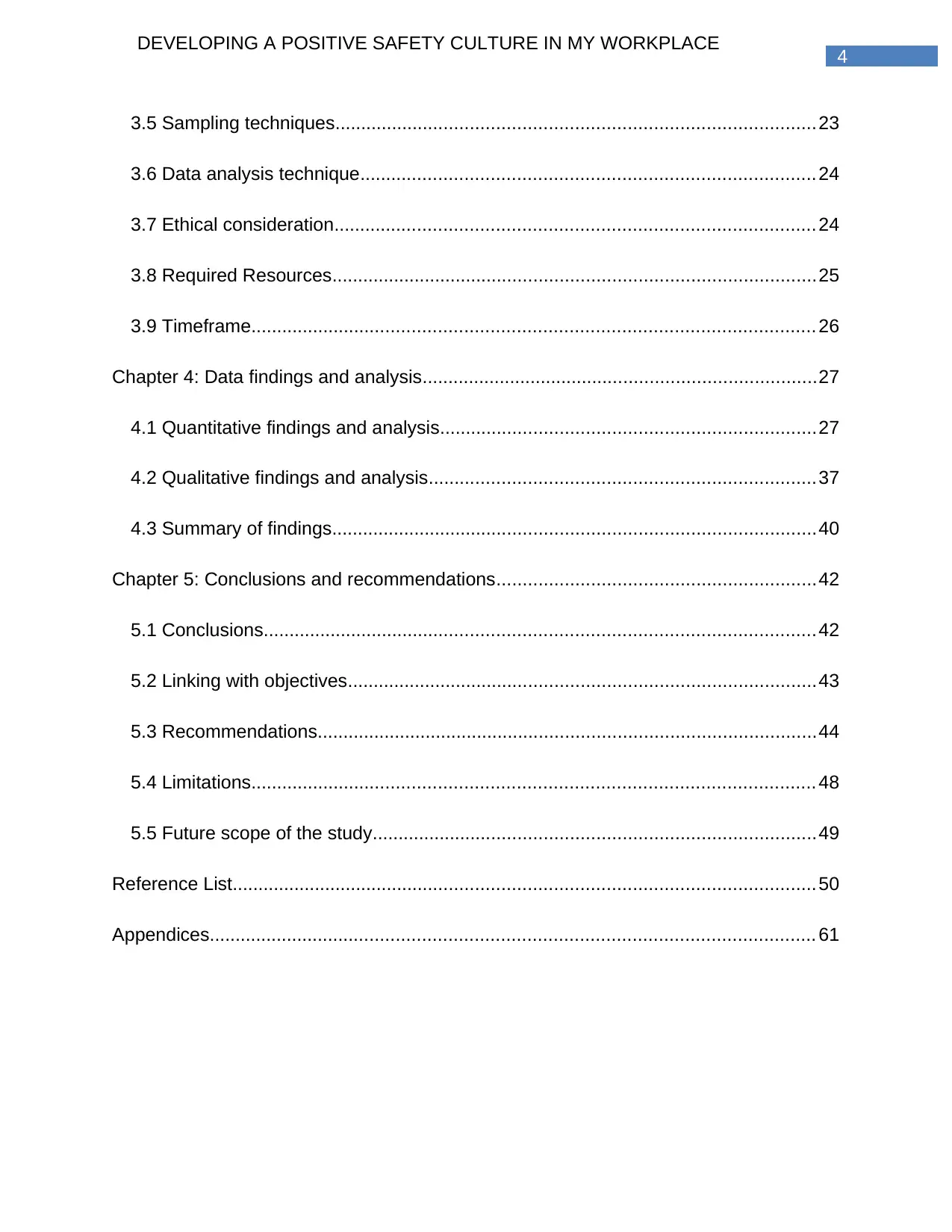
4
DEVELOPING A POSITIVE SAFETY CULTURE IN MY WORKPLACE
3.5 Sampling techniques............................................................................................23
3.6 Data analysis technique....................................................................................... 24
3.7 Ethical consideration............................................................................................ 24
3.8 Required Resources.............................................................................................25
3.9 Timeframe............................................................................................................ 26
Chapter 4: Data findings and analysis............................................................................27
4.1 Quantitative findings and analysis........................................................................27
4.2 Qualitative findings and analysis..........................................................................37
4.3 Summary of findings.............................................................................................40
Chapter 5: Conclusions and recommendations.............................................................42
5.1 Conclusions..........................................................................................................42
5.2 Linking with objectives..........................................................................................43
5.3 Recommendations................................................................................................44
5.4 Limitations............................................................................................................ 48
5.5 Future scope of the study.....................................................................................49
Reference List................................................................................................................ 50
Appendices.................................................................................................................... 61
DEVELOPING A POSITIVE SAFETY CULTURE IN MY WORKPLACE
3.5 Sampling techniques............................................................................................23
3.6 Data analysis technique....................................................................................... 24
3.7 Ethical consideration............................................................................................ 24
3.8 Required Resources.............................................................................................25
3.9 Timeframe............................................................................................................ 26
Chapter 4: Data findings and analysis............................................................................27
4.1 Quantitative findings and analysis........................................................................27
4.2 Qualitative findings and analysis..........................................................................37
4.3 Summary of findings.............................................................................................40
Chapter 5: Conclusions and recommendations.............................................................42
5.1 Conclusions..........................................................................................................42
5.2 Linking with objectives..........................................................................................43
5.3 Recommendations................................................................................................44
5.4 Limitations............................................................................................................ 48
5.5 Future scope of the study.....................................................................................49
Reference List................................................................................................................ 50
Appendices.................................................................................................................... 61
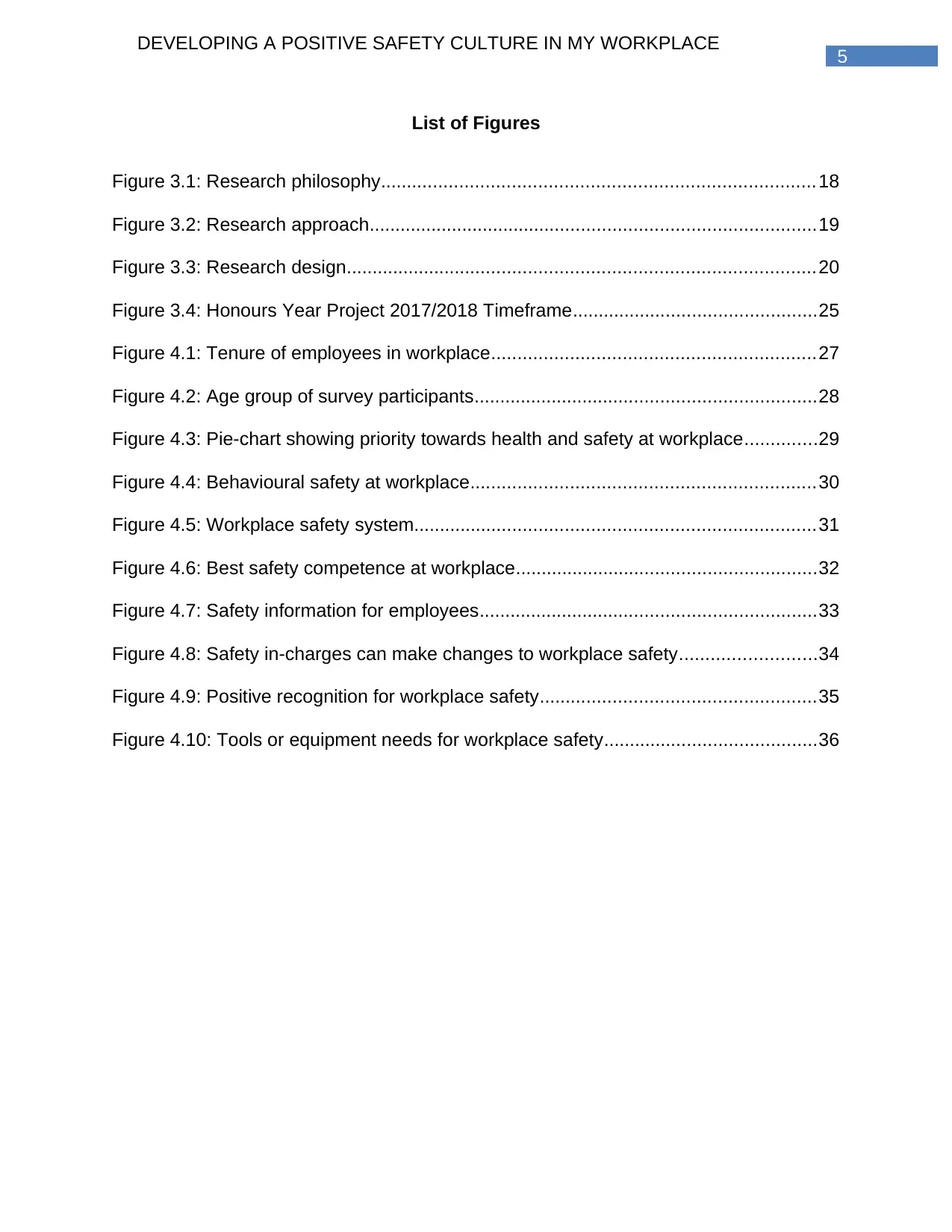
5
DEVELOPING A POSITIVE SAFETY CULTURE IN MY WORKPLACE
List of Figures
Figure 3.1: Research philosophy................................................................................... 18
Figure 3.2: Research approach......................................................................................19
Figure 3.3: Research design..........................................................................................20
Figure 3.4: Honours Year Project 2017/2018 Timeframe...............................................25
Figure 4.1: Tenure of employees in workplace..............................................................27
Figure 4.2: Age group of survey participants..................................................................28
Figure 4.3: Pie-chart showing priority towards health and safety at workplace..............29
Figure 4.4: Behavioural safety at workplace..................................................................30
Figure 4.5: Workplace safety system.............................................................................31
Figure 4.6: Best safety competence at workplace..........................................................32
Figure 4.7: Safety information for employees.................................................................33
Figure 4.8: Safety in-charges can make changes to workplace safety..........................34
Figure 4.9: Positive recognition for workplace safety.....................................................35
Figure 4.10: Tools or equipment needs for workplace safety.........................................36
DEVELOPING A POSITIVE SAFETY CULTURE IN MY WORKPLACE
List of Figures
Figure 3.1: Research philosophy................................................................................... 18
Figure 3.2: Research approach......................................................................................19
Figure 3.3: Research design..........................................................................................20
Figure 3.4: Honours Year Project 2017/2018 Timeframe...............................................25
Figure 4.1: Tenure of employees in workplace..............................................................27
Figure 4.2: Age group of survey participants..................................................................28
Figure 4.3: Pie-chart showing priority towards health and safety at workplace..............29
Figure 4.4: Behavioural safety at workplace..................................................................30
Figure 4.5: Workplace safety system.............................................................................31
Figure 4.6: Best safety competence at workplace..........................................................32
Figure 4.7: Safety information for employees.................................................................33
Figure 4.8: Safety in-charges can make changes to workplace safety..........................34
Figure 4.9: Positive recognition for workplace safety.....................................................35
Figure 4.10: Tools or equipment needs for workplace safety.........................................36
⊘ This is a preview!⊘
Do you want full access?
Subscribe today to unlock all pages.

Trusted by 1+ million students worldwide

6
DEVELOPING A POSITIVE SAFETY CULTURE IN MY WORKPLACE
List of Tables
Table 4.1: Tenure of employees in workplace................................................................26
Table 4.2: Age group of survey participants...................................................................27
Table 4.3: Priority towards health and safety at workplace............................................28
Table 4.4: Behavioural safety at workplace....................................................................29
Table 4.5: Workplace health and safety at workplace....................................................30
Table 4.6: Best safety competence at workplace...........................................................31
Table 4.7: Safety information for employees..................................................................32
Table 4.8: Safety in-charges can make changes to workplace safety............................33
Table 4.9: Positive recognition for workplace safety......................................................34
Table 4.10: Tools or equipment needs for workplace safety..........................................35
Table 4.1: Action plan for identification of hazards and risk assessment.......................43
Table 4.2: Developing written process and programme.................................................44
Table 5.3: Action plan for educating the employees......................................................46
DEVELOPING A POSITIVE SAFETY CULTURE IN MY WORKPLACE
List of Tables
Table 4.1: Tenure of employees in workplace................................................................26
Table 4.2: Age group of survey participants...................................................................27
Table 4.3: Priority towards health and safety at workplace............................................28
Table 4.4: Behavioural safety at workplace....................................................................29
Table 4.5: Workplace health and safety at workplace....................................................30
Table 4.6: Best safety competence at workplace...........................................................31
Table 4.7: Safety information for employees..................................................................32
Table 4.8: Safety in-charges can make changes to workplace safety............................33
Table 4.9: Positive recognition for workplace safety......................................................34
Table 4.10: Tools or equipment needs for workplace safety..........................................35
Table 4.1: Action plan for identification of hazards and risk assessment.......................43
Table 4.2: Developing written process and programme.................................................44
Table 5.3: Action plan for educating the employees......................................................46
Paraphrase This Document
Need a fresh take? Get an instant paraphrase of this document with our AI Paraphraser

7
DEVELOPING A POSITIVE SAFETY CULTURE IN MY WORKPLACE
Chapter 1: Introduction
According to Workplace Safety & Health Act, hazards can be understood as any
source of potential hard or damage or negative health impact, and hence is the potential
for adverse effects. It is differentiable from ‘harm' which can be understood as physical
injury or damage to health. Workplace hazards can be caused due to many different
sources including substances, materials and practice that can cause injury or harm to
individuals.
1.1 Background of the project
In a workplace, hazardous conditions etc. act or condition can be caused due to
a release of uncontrolled energy under different circumstances like: falling objects,
uncontrolled chemical reaction, release of compressed steam or gas and entangled
equipment, contact with electrode, capacitor or battery (Ccohs.ca 2018). Such events
can have several adverse effects on the health of the individuals, like bodily injury,
reduction in lifespan, effect on mental well being due to exposure to stress, trauma, or
chemical solvents and effect on the resiliency to deal with stress (Keane 2015).
Poor work practices also can cause hazards in the workplace. Different examples
of unsafe work practice includes: usage of equipment without prior authorization,
ignoring safety guidelines and work practice, removing any safety device on machinery
or equipment, using defective or malfunctioning tools or equipment, unsafe usage of
tools or equipment, unsafe or improper handling of materials and working procedures
(Ammendolia et al. 2016). It could be included to repairing or maintaining equipment
that are operating, failure to use protective equipment and safety device, unhealthy or
DEVELOPING A POSITIVE SAFETY CULTURE IN MY WORKPLACE
Chapter 1: Introduction
According to Workplace Safety & Health Act, hazards can be understood as any
source of potential hard or damage or negative health impact, and hence is the potential
for adverse effects. It is differentiable from ‘harm' which can be understood as physical
injury or damage to health. Workplace hazards can be caused due to many different
sources including substances, materials and practice that can cause injury or harm to
individuals.
1.1 Background of the project
In a workplace, hazardous conditions etc. act or condition can be caused due to
a release of uncontrolled energy under different circumstances like: falling objects,
uncontrolled chemical reaction, release of compressed steam or gas and entangled
equipment, contact with electrode, capacitor or battery (Ccohs.ca 2018). Such events
can have several adverse effects on the health of the individuals, like bodily injury,
reduction in lifespan, effect on mental well being due to exposure to stress, trauma, or
chemical solvents and effect on the resiliency to deal with stress (Keane 2015).
Poor work practices also can cause hazards in the workplace. Different examples
of unsafe work practice includes: usage of equipment without prior authorization,
ignoring safety guidelines and work practice, removing any safety device on machinery
or equipment, using defective or malfunctioning tools or equipment, unsafe usage of
tools or equipment, unsafe or improper handling of materials and working procedures
(Ammendolia et al. 2016). It could be included to repairing or maintaining equipment
that are operating, failure to use protective equipment and safety device, unhealthy or
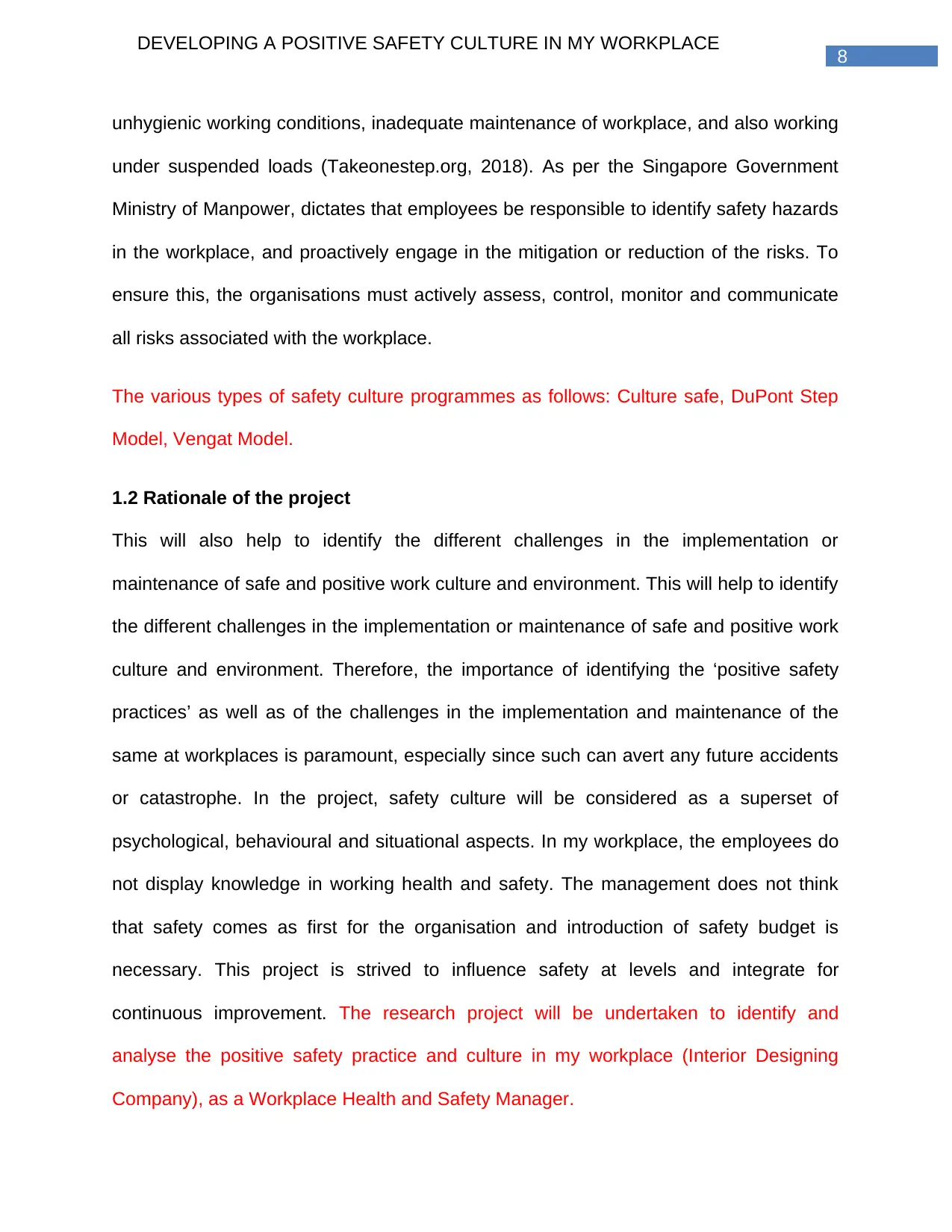
8
DEVELOPING A POSITIVE SAFETY CULTURE IN MY WORKPLACE
unhygienic working conditions, inadequate maintenance of workplace, and also working
under suspended loads (Takeonestep.org, 2018). As per the Singapore Government
Ministry of Manpower, dictates that employees be responsible to identify safety hazards
in the workplace, and proactively engage in the mitigation or reduction of the risks. To
ensure this, the organisations must actively assess, control, monitor and communicate
all risks associated with the workplace.
The various types of safety culture programmes as follows: Culture safe, DuPont Step
Model, Vengat Model.
1.2 Rationale of the project
This will also help to identify the different challenges in the implementation or
maintenance of safe and positive work culture and environment. This will help to identify
the different challenges in the implementation or maintenance of safe and positive work
culture and environment. Therefore, the importance of identifying the ‘positive safety
practices’ as well as of the challenges in the implementation and maintenance of the
same at workplaces is paramount, especially since such can avert any future accidents
or catastrophe. In the project, safety culture will be considered as a superset of
psychological, behavioural and situational aspects. In my workplace, the employees do
not display knowledge in working health and safety. The management does not think
that safety comes as first for the organisation and introduction of safety budget is
necessary. This project is strived to influence safety at levels and integrate for
continuous improvement. The research project will be undertaken to identify and
analyse the positive safety practice and culture in my workplace (Interior Designing
Company), as a Workplace Health and Safety Manager.
DEVELOPING A POSITIVE SAFETY CULTURE IN MY WORKPLACE
unhygienic working conditions, inadequate maintenance of workplace, and also working
under suspended loads (Takeonestep.org, 2018). As per the Singapore Government
Ministry of Manpower, dictates that employees be responsible to identify safety hazards
in the workplace, and proactively engage in the mitigation or reduction of the risks. To
ensure this, the organisations must actively assess, control, monitor and communicate
all risks associated with the workplace.
The various types of safety culture programmes as follows: Culture safe, DuPont Step
Model, Vengat Model.
1.2 Rationale of the project
This will also help to identify the different challenges in the implementation or
maintenance of safe and positive work culture and environment. This will help to identify
the different challenges in the implementation or maintenance of safe and positive work
culture and environment. Therefore, the importance of identifying the ‘positive safety
practices’ as well as of the challenges in the implementation and maintenance of the
same at workplaces is paramount, especially since such can avert any future accidents
or catastrophe. In the project, safety culture will be considered as a superset of
psychological, behavioural and situational aspects. In my workplace, the employees do
not display knowledge in working health and safety. The management does not think
that safety comes as first for the organisation and introduction of safety budget is
necessary. This project is strived to influence safety at levels and integrate for
continuous improvement. The research project will be undertaken to identify and
analyse the positive safety practice and culture in my workplace (Interior Designing
Company), as a Workplace Health and Safety Manager.
⊘ This is a preview!⊘
Do you want full access?
Subscribe today to unlock all pages.

Trusted by 1+ million students worldwide

9
DEVELOPING A POSITIVE SAFETY CULTURE IN MY WORKPLACE
Risk can be understood as the propensity of an individual of being and the
propensity of an event occurring is affected by the nature of exposure, the mode of
exposure and the severity of the effect of the exposure (Thepaksorn et al. 2017).
Therefore, assessment of risks is aimed to identify the hazards and risks that can cause
harm, moreover, the risks that are associated with the identified hazard, and
determination of effective method to mitigate or control the hazard or risk. The common
hazards can also be categorized into several types: biological hazard (like bacteria,
viruses, insects, birds, plants and humans), chemical hazard (depending on the
properties of the chemical), ergonomic hazard (due to repetitive motions or incorrect
placement or usage of equipment), physical hazard (due to radiation, magnetic field,
extreme pressure or notice), psychosocial hazard (like violence or stress), and safety
hazard (due to tripping, slipping, improperly guarding machines, or malfunctions and
breakdown of equipment). Based on topology, the hazard can also be categorized as
Obvious, Trivial, Emerging and Hidden (Bahn 2013). The Workplace Safety and Health
(WSH) regulation requires risk assessment and monitoring of all work activities and
communicating the risks to all stakeholders. The WSH council's functions include
building the capabilities of industries to manage WSH, promote health and safety in the
workplace, and implement WSH practices (Wshc.sg 2018).
1.3 Aim
The objective of the proposal is to identify and analyse the safety practice and
culture, and also the challenges to the maintenance of positive and safe work
environment
DEVELOPING A POSITIVE SAFETY CULTURE IN MY WORKPLACE
Risk can be understood as the propensity of an individual of being and the
propensity of an event occurring is affected by the nature of exposure, the mode of
exposure and the severity of the effect of the exposure (Thepaksorn et al. 2017).
Therefore, assessment of risks is aimed to identify the hazards and risks that can cause
harm, moreover, the risks that are associated with the identified hazard, and
determination of effective method to mitigate or control the hazard or risk. The common
hazards can also be categorized into several types: biological hazard (like bacteria,
viruses, insects, birds, plants and humans), chemical hazard (depending on the
properties of the chemical), ergonomic hazard (due to repetitive motions or incorrect
placement or usage of equipment), physical hazard (due to radiation, magnetic field,
extreme pressure or notice), psychosocial hazard (like violence or stress), and safety
hazard (due to tripping, slipping, improperly guarding machines, or malfunctions and
breakdown of equipment). Based on topology, the hazard can also be categorized as
Obvious, Trivial, Emerging and Hidden (Bahn 2013). The Workplace Safety and Health
(WSH) regulation requires risk assessment and monitoring of all work activities and
communicating the risks to all stakeholders. The WSH council's functions include
building the capabilities of industries to manage WSH, promote health and safety in the
workplace, and implement WSH practices (Wshc.sg 2018).
1.3 Aim
The objective of the proposal is to identify and analyse the safety practice and
culture, and also the challenges to the maintenance of positive and safe work
environment
Paraphrase This Document
Need a fresh take? Get an instant paraphrase of this document with our AI Paraphraser
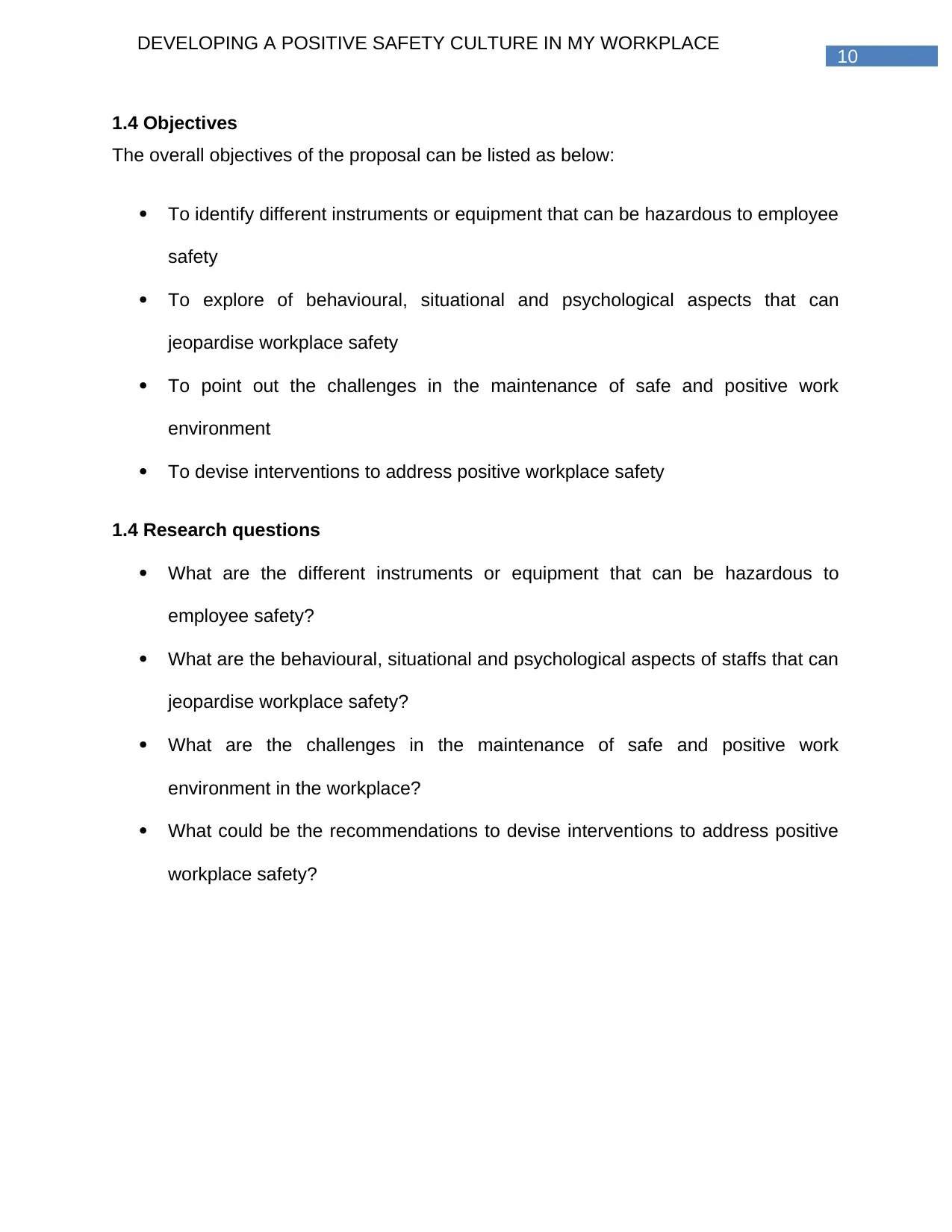
10
DEVELOPING A POSITIVE SAFETY CULTURE IN MY WORKPLACE
1.4 Objectives
The overall objectives of the proposal can be listed as below:
To identify different instruments or equipment that can be hazardous to employee
safety
To explore of behavioural, situational and psychological aspects that can
jeopardise workplace safety
To point out the challenges in the maintenance of safe and positive work
environment
To devise interventions to address positive workplace safety
1.4 Research questions
What are the different instruments or equipment that can be hazardous to
employee safety?
What are the behavioural, situational and psychological aspects of staffs that can
jeopardise workplace safety?
What are the challenges in the maintenance of safe and positive work
environment in the workplace?
What could be the recommendations to devise interventions to address positive
workplace safety?
DEVELOPING A POSITIVE SAFETY CULTURE IN MY WORKPLACE
1.4 Objectives
The overall objectives of the proposal can be listed as below:
To identify different instruments or equipment that can be hazardous to employee
safety
To explore of behavioural, situational and psychological aspects that can
jeopardise workplace safety
To point out the challenges in the maintenance of safe and positive work
environment
To devise interventions to address positive workplace safety
1.4 Research questions
What are the different instruments or equipment that can be hazardous to
employee safety?
What are the behavioural, situational and psychological aspects of staffs that can
jeopardise workplace safety?
What are the challenges in the maintenance of safe and positive work
environment in the workplace?
What could be the recommendations to devise interventions to address positive
workplace safety?

11
DEVELOPING A POSITIVE SAFETY CULTURE IN MY WORKPLACE
Chapter 2: Literature review
2.1 Making a commitment to safety culture
Christian et al. (2009) identified different factors associated with and influences
workplace safety. These factors directly contribute to or affect the climate of safety in an
organisation. The distal situation related factors and person-related factors affects the
proximal person-related factors, which in turn influences the safety performance, and
hence the safety outcomes (Antonsen 2017).Safety is a key concern that has been
identified as ‘lacking’ in the interior designing industry. Improvement in the status quo
can only be possible by leading the movement to ensure a safe and healthy work
environment in this industry, for other organisations to follow. Studies show that a
culture of safety can prevent injuries at work. Averting injuries would also imply a
reduction in the costs incurred by the organisation, and expenses incurred to ensure a
safe work environment can be a long-term investment towards mitigation of hazards
and expenses incurred due to them (Trincheroet al. 2017). Therefore several authors
have maintained a view of safe work culture as an invaluable strategy, and several
studies also point towards the same. The risk assessment should be able to identify
hazards, evaluate its risk, and outline means for controlling them. Additionally, the risk
assessment team should involve the management, process or facility engineer,
technical staff, supervisor, production workers, maintenance crew, safety crew as well
as contractors and suppliers (Mom.gov.sg 2018). Investigation of any events, illness, or
injuries should also be done to find their causes, and prevent further recurrence if
DEVELOPING A POSITIVE SAFETY CULTURE IN MY WORKPLACE
Chapter 2: Literature review
2.1 Making a commitment to safety culture
Christian et al. (2009) identified different factors associated with and influences
workplace safety. These factors directly contribute to or affect the climate of safety in an
organisation. The distal situation related factors and person-related factors affects the
proximal person-related factors, which in turn influences the safety performance, and
hence the safety outcomes (Antonsen 2017).Safety is a key concern that has been
identified as ‘lacking’ in the interior designing industry. Improvement in the status quo
can only be possible by leading the movement to ensure a safe and healthy work
environment in this industry, for other organisations to follow. Studies show that a
culture of safety can prevent injuries at work. Averting injuries would also imply a
reduction in the costs incurred by the organisation, and expenses incurred to ensure a
safe work environment can be a long-term investment towards mitigation of hazards
and expenses incurred due to them (Trincheroet al. 2017). Therefore several authors
have maintained a view of safe work culture as an invaluable strategy, and several
studies also point towards the same. The risk assessment should be able to identify
hazards, evaluate its risk, and outline means for controlling them. Additionally, the risk
assessment team should involve the management, process or facility engineer,
technical staff, supervisor, production workers, maintenance crew, safety crew as well
as contractors and suppliers (Mom.gov.sg 2018). Investigation of any events, illness, or
injuries should also be done to find their causes, and prevent further recurrence if
⊘ This is a preview!⊘
Do you want full access?
Subscribe today to unlock all pages.

Trusted by 1+ million students worldwide
1 out of 62
Related Documents
Your All-in-One AI-Powered Toolkit for Academic Success.
+13062052269
info@desklib.com
Available 24*7 on WhatsApp / Email
![[object Object]](/_next/static/media/star-bottom.7253800d.svg)
Unlock your academic potential
Copyright © 2020–2025 A2Z Services. All Rights Reserved. Developed and managed by ZUCOL.





